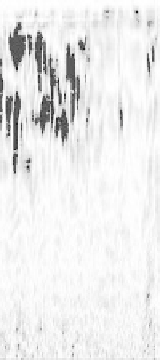Geoscience Reference
In-Depth Information
AB
A
B
0
Live 18 g
Dead 87 g
Total 105 g
Live 82 g
Dead 30 g
Total 112 g
GPR index
2013
GPR index
1910
1
0
1.2
Transect length (m)
fIGURe 30.3
Two locations (A and B) were scanned in an area of high reflectivity at Sanderson, Florida,
and destructively sampled with a 15 cm diameter soil core. Core A had low root density and a large mass of
dead material, the opposite ratio was observed in core B. Ground-penetrating radar (GPR) could not discrimi-
nate between roots and dead organic material.
When live and dead root mass were combined, a strong positive relationship was observed with the
GPR data (r = 0.80). The high proportion of buried organic debris at Sanderson limits the utility of
the technique to detect live roots. At KSC the correlation between GPR and live roots was much
better (r = 0.84). The Sanderson findings highlight the fact that presently, it is not possible to sepa-
rate live and dead buried biomass. At KSC, dead biomass represented only 13 percent of the total
buried biomass which clearly enhanced the accuracy of root biomass using GPR. When the live and
dead root mass were combined at KSC and compared to GPR-derived predictions the correlation
was excellent (r = 0.82). Previous forest studies minimized the importance of understanding the
reflectivity of organic debris; it was thought that dead roots rapidly took on dielectric properties
of the surrounding soil (Butnor et al., 2001). The issue of organic debris never came up at a site in
Bainbridge, Georgia, which had been used and plowed for decades in traditional agricultural sys-
tems, exposing any residual debris to oxidation (Butnor et al., 2003). GPR has subsequently been
used to detect dead root fragments in peach orchards (
Prunus persica
) to specifically identify and
quantify organic debris that harbors harmful fungi (
Armillaria
sp.) that could be detrimental to
new plantings (Cox et al., 2005). At Sanderson, the problem of interfering organic debris resulting
from site preparation was likely exacerbated by the preponderance of saw palmetto which is decay
resistant compared to other forest slash.
When monitoring root development and accretion over time, it is important for small changes
to be detected. The sandy soils at KSC drain rapidly, producing little change in radargram analysis,
except in the case of saturated field moisture conditions. GPR data interpretation and predictive
root biomass equations are not limited to just conditions present at the time of core collection on
very coarse soils, but this should be verified for specific sites. The Sanderson site was remeasured
in 2003, 2004, and 2005, and a very interesting phenomenon was observed. The primary research
goal was to determine the effect of genetic improvement, tree spacing, and fertilizer application on
tree productivity (above- and belowground). Between 2004 and 2005, there was an apparent and
unexpected drop in belowground biomass as estimated with GPR. Approximately 10 percent of
the survey was remeasured with litter in place and again with litter removed to quantify the effects
of litter on root resolution. Scanning through the dry, air-filled leaf litter served to defocus the







